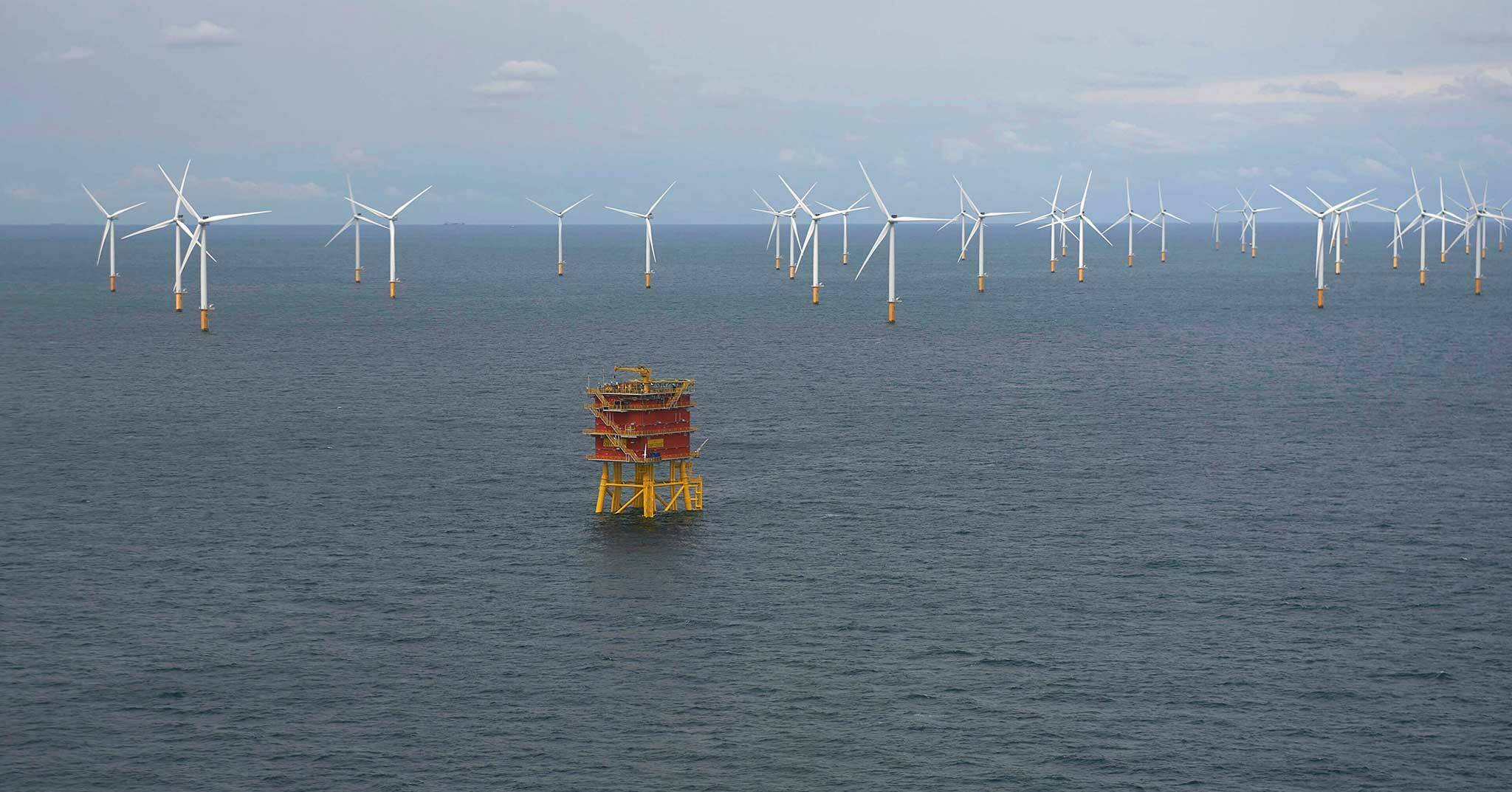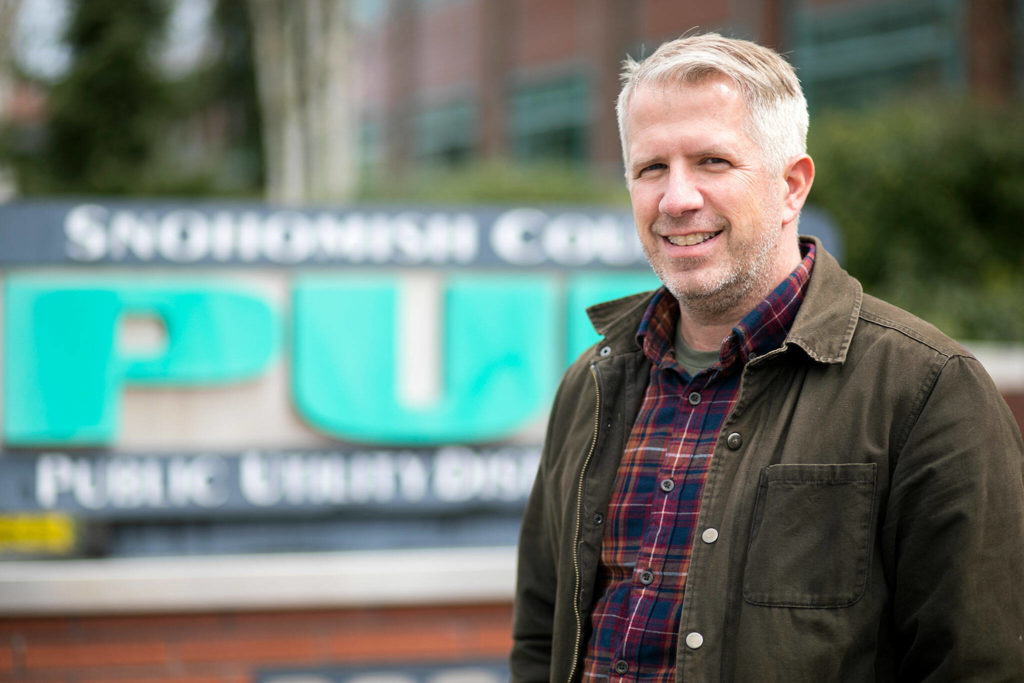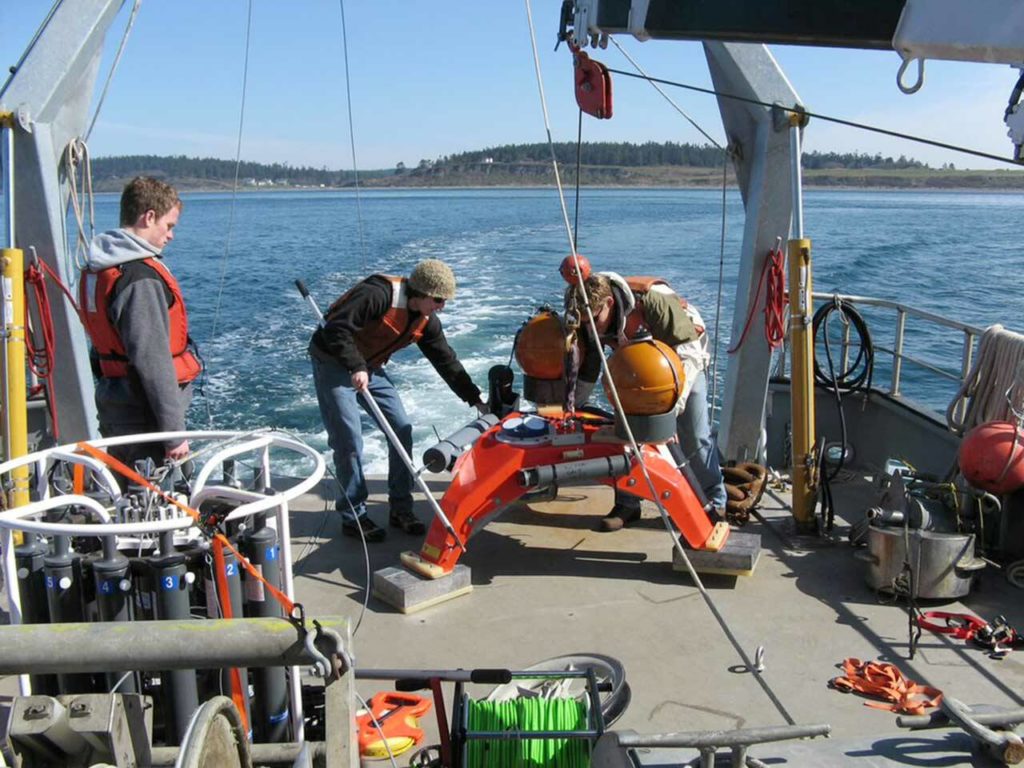EVERETT — After seven years of effort, it didn’t get off the ground. Or onto the floor of Puget Sound. But the Admiralty Inlet tidal energy pilot project that the Snohomish Public Utility District dropped in 2014 is legendary in the Northwest’s clean energy circles.
Eight years later, offshore energy, also called marine energy, is gaining momentum in the Northwest. Researchers, regulators and businesses are keen to harness the power of tidal currents, waves and wind. Wind turbines in the Pacific Ocean offer the most promise for augmenting the region’s hydropower supply.
Human-caused climate change is the driving force behind the transition, said Jason Busch, executive director of the Pacific Ocean Energy Trust.
“It is the most relevant underlying dynamic that governs how we think about offshore energy,” he said. “It’s not about economic development, it’s not about profit, though it has enormous economic potential.”
Up-front costs and regulatory hurdles are high, Busch said. But when offshore energy systems are in place, Nature doesn’t charge to “fill the tank” with fuel.
The Snohomish PUD project, planned west of Whidbey Island, would have relied on tidal surges that pulse twice daily through Puget Sound. Busch is among the energy policy experts and researchers who say the effort was ahead of its time, using words like “extremely progressive” and “forward thinking.”
“Folks were excited. For a local utility to be engaged — that was unprecedented,” said Busch, adding: “We estimated the sheer difficulty of getting anything in the water.”
While the Snohomish PUD’s everyday power supply is made up of hydro, wind, solar and nuclear, when demand is high it sometimes buys additional power generated by coal or natural gas. Steven Klein, the PUD’s general manager at the time, was keen to try tidal power as another non-carbon-emitting energy source. Federal dollars were available to help pay for a pilot project.
“We recognized the technology was in its infancy,” said Scott Spahr, the PUD’s generation engineering manager, who was involved with the effort. “We thought, ‘We’re going to be pioneers and it’s got this really rewarding component to it: It’s predictable.’” Unlike wind.
And unlike wind towers and blades, the two underwater turbines supplied by an Irish company would not be visible. Buried cable would carry power to a beach-side control center near Fort Casey State Park.
Obstacles emerged, including the common ones faced by other offshore energy projects. Tribes worried it would harm declining salmon populations. Undersea cable companies feared damage to communication cables and the precedent set by even a small project. But the Federal Energy Regulatory Agency was convinced by the PUD’s assurances of minimal impact, enough to bestow its first deep-water tidal energy license on the project.
By that time, the cost of the project had tripled. The U.S. Department of Energy grant to pay for half the projected cost was not going to get any larger. So the PUD discontinued the project.
”It was definitely a sad day,” said Spahr, a self-described renewable energy geek. In his 13 years at the PUD, the district has invested in a biodigester that turns farm waste into methane gas, set up an experimental solar array and even drilled a nearly one-mile-deep well at Garland Mineral Springs, only to learn the water wasn’t hot enough to produce geothermal energy.
The PUD has no plans to try tidal energy again, said Garrison Marr, senior manager of power supply. But staff is watching offshore wind development with interest. And because “the most exciting wind is not in Puget Sound,” as Marr put it, their eyes are on the blustery Pacific Coast.
World-class wind
Energy experts rhapsodize over the world-class wind off northern California and southern Oregon. The sweet spot is between Humboldt County and Coos Bay, and that’s where international companies are looking to launch the Northwest’s offshore wind complex and where the federal government has offered the first leases for West Coast wind production. Not only does the wind blow consistently, but it picks up in winter just when the region is cold, dark and needing more power.
Anyone familiar with Atlantic Ocean wind farm controversies might wonder if there will be choruses of coast dwellers complaining about giant towers marring their water views. The answer is no, apparently, for two reasons. For one, companies have learned that’s a political battle they don’t want to fight. For another, says wind expert Travis Douville, the West Coast continental shelf is too deep to embed a platform foundation.
The solution? Floating platforms, 20 miles offshore. Out of sight, but also more challenging and expensive to maintain. And even floating platforms need mooring lines to the sea floor, said Douville, a project manager with the Pacific Northwest National Laboratory (PPNL). And they face the usual concerns about impacts on wildlife, vessel traffic, fishing rights.
Offshore wind turbines can be a lot taller and larger than those onshore, making them far more efficient at creating electricity. How big? Four times larger than those on land. General Electric is building an offshore turbine that is 853 feet high. In comparison, the Space Needle towers 605 feet.
The scale of the machines is hard to grasp, said Brian Polagye of the University of Washington. He is director of the Pacific Marine Energy Center, which unifies research and education programs across UW, Oregon State University and the University of Alaska Fairbanks. A single offshore rotor blade can be as long as a football field, Polagye said, noting the transportation problems involved: “I’m told the limitation is the longest blade you can put on a truck and still make a right turn. You can’t make a right turn with a football field on back of a truck.”
Europe, which has the only offshore floating platforms so far, is building dedicated ships for turbine transport. Engineers are investigating blades that can be made in segments, as well as telescoping towers. The turbines require a lot of onshore space near the wind installation for final assembly, which leaves out Snohomish County. But could parts for a wind installation be made in a manufacturing hub like this one, despite its distance from the coastal action?
“It has to be made somewhere, and the coast doesn’t have as much industrial capacity,” said Polagye, who envisions a big supply chain developing to serve the industry. And he sees offshore wind coming to Washington, possibly in the next five years.
“I thought offshore wind at large scale was at least 10 years off in Washington, but that has changed dramatically in the last few years as the scale of offshore turbines has expanded and costs have come down significantly,” he said.
Seattle-based Trident Winds agrees. In March, it submitted a request with the Bureau of Ocean and Energy Management to build the Olympic Winds project off the Washington coast. Two cables, extending from 45 miles offshore to the Quinault Beach Resort and Westport, would carry power to Grays Harbor Public Utility District substations — enough electricity for 400,000 households. Trident’s founder and CEO, Alla Weinstein, is a member of the Washington Coastal Marine Advisory Council.
If offshore wind lives up to its gigawatt potential, the need for more power lines from the coast is one of many logistical and environmental obstacles to be overcome. But the region made such a transformation before when it built out a hydropower system, experts note. And there are government deadlines to meet. Washington’s goal is net-zero carbonization by 2050, and the climate-driven “electrification of everything” is escalating demand for clean energy.
Capturing waves
It’s not surprising that wind energy is advanced. It was one of our longest-standing sources of energy. “When was the first windmill built for grinding grain?” asks Bryson Robertson, Pacific Marine Energy Center co-director at Oregon State University.
But capturing the energy of the restless seas? That’s new. Wave energy technology is new but the focus of much experimentation. Researchers are excited about PacWave, a new test site.
“Outside of Europe, it will be the premier, grid-connected test site,” Robertson said, opening for business in 2024. The fact that it is pre-permitted is enticing to companies who want to try out their wave capture technology.
PacWave is seven miles off the coast of Central Oregon, a site chosen by a local fishing company. Going first to stakeholders, rather than waiting for conflict to arise in the permitting process, is a lesson that marine energy experts consider a lesson learned.
Initially, wave energy is expected to have small-scale applications, like powering ocean research operations, aquaculture or mining seawater for hydrogen, said Busch, the Pacific Ocean Energy Trust director. He estimated there are 10 different fundamental designs of wave turbines. Waves could eventually provide energy to coastal communities, such as Alaskan villages that now rely on diesel fuel, he added.
Washington’s Makah Tribe is involved with University of Washington research, said UW’s Polagye. And this spring, researchers will demonstrate a small wave turbine at Agate Pass near Bremerton.
What’s up with tidal?
The idea of capturing tidal energy continues to intrigue researchers. In south-central Alaska, the National Renewable Energy Laboratory is leading studies of tidal energy at Cook Inlet, where it calculates 30% of U.S. tidal power can be found — enough potential energy to serve far more than Alaska’s population. Glacial sediment and submerged icebergs are among the challenges there.
There are tidal power plants in France and Korea, and small operations and test sites in such places as the United Kingdom, Nova Scotia, China and Russia.
Here in Puget Sound, researchers have identified the three best locations to capture tidal energy. One is Admiralty Inlet, where the Snohomish PUD abandoned its effort. The others are Tacoma Narrows in the South Sound, and Rosario Strait east of Lopez and Orcas islands. Orcas Power & Light Cooperative is investigating the potential of a Rosario tidal energy project with the help of a $150,000 state grant. Because energy costs are high in San Juan County compared to low regional rates, Polagye said, the investment might make sense.
Scientists have learned a lot about Puget Sound currents and the marine environment since the Snohomish PUD’s attempt. Turbine technology and monitoring are constantly improving. One thing that hasn’t improved is the speed of getting a permit. The federal scientists and regulators who worked on the Admiralty Inlet project were fantastic collaborators, Polagye said, but every year there are fewer of them to do the same job. And that, he noted, is a political problem, not a scientific one.
Busch also longs for faster approval. Permitting for PacWave took six or seven years of talking around the table, he said. Given the imminent threat of climate change, “one or two years for a test site ought to be more than enough.”
Julie Titone is an Everett writer who can be reached at julietitone@icloud.com and @julietitone. Her stories are supported by the Herald’s Environmental and Climate Reporting Fund. If you’d like to see more stories like this, donate to The Daily Herald’s Environmental and Climate Change Reporting Fund in partnership with Journalism Funding Partners. Go to heraldnet.com/climatedonate.
Talk to us
> Give us your news tips.
> Send us a letter to the editor.
> More Herald contact information.




























